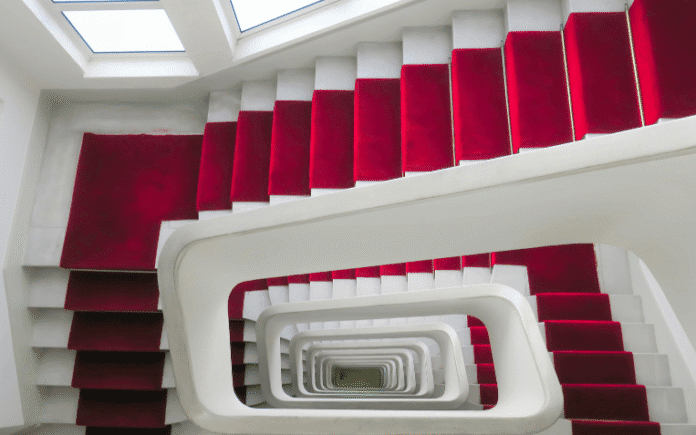Table of Contents
Introduction
When it comes to enhancing the beauty and safety of your home, choosing the best stair runners for wood stairs can be a game-changer. Stair runners add a touch of style and sophistication to your staircase and provide safety by preventing slips and falls. With various patterns, materials, and installation methods available, selecting the right stair runner can seem overwhelming.
Wood stairs are a beautiful focal point in any home, offering timeless appeal and natural warmth. However, they can also be slippery, noisy, and prone to wear and tear over time. This is where stair runners for wood stairs come in.
This comprehensive guide will explain the essential factors to consider when choosing stair runners, including patterns, materials, and DIY installation tips.
| Material Type | Durability | Slip Resistance | Style Options | Maintenance | Best For |
| Wool | High | Excellent | Classic, traditional | Low maintenance | High-traffic areas, long-term use |
| Nylon | High | Good | Wide range, modern looks | Easy to clean | Families with kids or pets |
| Polypropylene (Olefin) | Moderate | Fair | Bold, affordable patterns | Stain-resistant, easy clean | Budget-conscious, light-traffic stairs |
| Cotton | Moderate | Good | Natural, soft patterns | Requires regular cleaning | Cozy, less-trafficked stairs |
| Sisal/Natural Fibers | Moderate | Low | Rustic, textured appeal | Harder to clean | Aesthetic appeal, low-slip areas |
Understanding Stair Runners
What is a Stair Runner?
A stair runner is a long strip of carpeting that runs along the length of a staircase. It is typically narrower than the width of the stairs, allowing the wood to be visible on either side. Stair runners can be made from various materials and come in countless designs, making them a versatile choice for home decor.

Benefits of Stair Runners
- Safety: Stair runners provide traction, reducing the risk of slips and falls on wooden stairs.
- Comfort: They offer a softer surface underfoot, making stair climbing more comfortable.
- Noise Reduction: Runners can help dampen sound when walking on stairs, providing a quieter environment.
- Aesthetics: They enhance the visual appeal of your staircase, allowing for personalization through color and pattern.
Choosing the Best Stair Runners for Wood Stairs
When selecting a stair runner, consider the following factors: patterns, materials, and installation methods.
1. Patterns
The pattern of your stair runner can significantly influence the overall design of your staircase and home. Here are some popular pattern options:
| Pattern Type | Description | Best For |
| Solid Colors | Simple and elegant, ideal for a minimalist look. | Modern and contemporary styles. |
| Stripes | Creates a dynamic look, elongating the appearance of stairs. | Traditional and transitional decor. |
| Geometric | Offers a modern touch with bold shapes. | Contemporary and eclectic styles. |
| Floral | Adds a touch of softness and warmth. | Classic and vintage aesthetics. |
| Abstract | Unique designs that make a statement. | Artistic and creative spaces. |
2. Materials
The material of your stair runner affects both its durability and aesthetic appeal. Here are some common materials used for stair runners:
- Wool: Known for its durability and softness, wool is a popular choice for high-traffic areas. It is naturally stain-resistant and provides excellent insulation.
- Nylon: This synthetic material is highly durable and resistant to stains, making it an excellent option for homes with pets or children.
- Polyester: Offering a soft feel and vibrant colors, polyester is an affordable choice, though it may not be as durable as wool or nylon.
- Sisal: A natural fiber that provides a textured look, sisal is eco-friendly and durable, but can be harder on bare feet.
- Jute: Another natural fiber is soft and stylish but not as durable as other materials, making it better suited for low-traffic areas.
3. Color Selection
Choosing the right color for your stair runner is crucial. Consider the following tips:
- Coordinate with Surroundings: Choose a color that complements the existing decor, including wall colors, furniture, and wood tones.
- Consider Traffic: Lighter colors may show dirt and stains more quickly, while darker colors can better hide imperfections.
- Mood and Ambiance: Lighter colors can create an airy and spacious feel, while darker shades add warmth and coziness.

DIY Installation Tips for Stair Runners
Installing a stair runner can be a rewarding DIY project. Here are some essential tips to help you through the process:
1. Gather Your Materials
Before you begin, make sure you have all the necessary materials:
- Stair Runner: Choose the length and width that fits your staircase.
- Double-Sided Carpet Tape or Tack Strip: This secures the runner.
- Staple Gun: Optional, for additional securing.
- Measuring Tape: To measure your stairs and runner.
- Utility Knife: This is for cutting the runner to size.
- Scissors: For trimming edges.
2. Measure Your Stairs
Accurate measurements are crucial for a successful installation. Measure the width and length of each stair step, including the nosing, to determine how much runner you will need.
3. Cut the Runner
Cut the runner to the appropriate length, adding a little extra on each end to ensure complete coverage. Consider cutting the runner into individual pieces for each step if your stairs have a curved edge.
4. Prepare the Stairs
Ensure that the stair surface is clean and dry. Vacuum the steps to remove dust or debris, and lightly sand the edges for better adhesion.
5. Secure the Runner
- Using Double-Sided Tape: Lay the runner on the stairs and press it down firmly. Apply double-sided carpet tape along the edges for extra security.
- Using Tack Strips: If you prefer a more permanent solution, install tack strips along the edges of the stairs and press the runner into the tack strip.
6. Trim and Finish
Trim any excess material once the runner is secured using a utility knife. Ensure the edges are neatly finished and the runner lies flat against the stairs.
7. Allow to Set
After installation, avoid using the stairs for at least 24 hours to allow the adhesive to set correctly.
Matching Stair Runners with Interior Styles
Match your runner with the overall decor of your home for a seamless look:
- Modern: Geometric patterns in grayscale or bold colors.
- Traditional: Floral or oriental motifs in rich tones.
- Rustic: Natural fibers like sisal with neutral shades.
- Minimalist: Solid or subtly striped designs.
Use stair rods or brass stair clips for added character and grip.

Long-Term Maintenance Tips for Stair Runners for Wood Stairs
To keep your stair runner looking its best, follow these maintenance tips:
1. Regular Vacuuming
Vacuum your stair runner regularly to remove dirt and debris. Use a vacuum with a brush attachment to avoid damaging the fibers.
2. Spot Cleaning
Address spills and stains immediately using a mild detergent and a clean cloth. Blot the area gently to prevent the stain from spreading.
3. Professional Cleaning
Consider having your stair runner professionally cleaned every few years to maintain its appearance and extend its lifespan.
4. Rotate the Runner
If your runner is reversible, consider flipping it periodically to ensure even wear and tear.

Best Stair Runners for Wood Stairs: Top Brand Picks
Some top-rated brands for quality stair runners include:
- Safavieh: Known for elegant wool and traditional patterns.
- nuLOOM: Affordable and stylish synthetic options.
- Dash & Albert: Offers a wide variety of materials and bold patterns.
- Mohawk Home: Durable, budget-friendly synthetic runners.
- Rugshop: Great for geometric and modern prints.
Make sure to read reviews and choose a runner that fits your traffic level, style, and budget.
Conclusion
Choosing the best stair runners for wood stairs involves considering various factors, including patterns, materials, and installation methods. By understanding the options available, you can select a runner that enhances your home’s aesthetic while providing safety and comfort.
Whether you opt for a bold geometric design or a classic floral pattern, the right stair runner can elevate your staircase and complete your home’s look. With the DIY installation tips, you can confidently undertake this project, transforming your stairs into a stunning focal point in your home. Enjoy enhancing your space with a beautiful and functional stair runner!
Apart from that, if you are interested to know about “Up and Down: Navigating the Essential Parts of Your Staircase” then visit our “Home Improvement” category.
FAQs
Yes, but it requires custom cutting and advanced installation techniques. In such cases, hiring a professional is often recommended.
Yes, especially when installed securely. Choose non-slip materials and ensure the runner is tightly fastened to prevent shifting or tripping.
Geometric, striped, and herringbone patterns are popular as they hide dirt and wear. Choose a design that complements your interior style.
Vacuum regularly to prevent dirt buildup. Spot clean spills immediately, and deep clean every 6–12 months, depending on traffic.
















